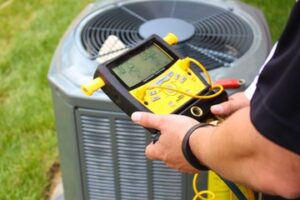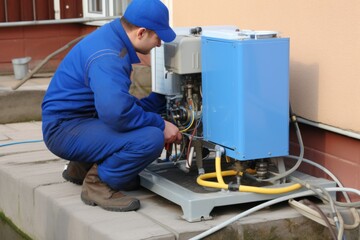In every indoor space, comfort relies heavily on invisible climate control. Heating, ventilation, and air conditioning, commonly known as HVAC, has quietly evolved. This silent evolution affects more than just temperature. It now touches energy, health, and technology in exciting ways.

Recent designs of HVAC systems are prioritizing air purification alongside temperature control. Specialized filters and UV light treatments are being integrated into standard units. These updates aim to minimize bacteria, viruses, and allergens in circulated air. Cleaner indoor air promotes better overall wellness. Keep reading the article below to learn more about 24 Hour HVAC Company.
Another emerging trend in HVAC technology focuses on self-diagnosis features. Systems are being built with sensors that detect when maintenance is needed. Instead of waiting for breakdowns, users are alerted early through mobile notifications. This proactive care extends the lifespan of systems significantly.
Artificial intelligence is finding its way into HVAC systems in remarkable ways. Machine learning algorithms study user habits and adjust temperatures automatically. As people move from room to room, smart HVAC adapts without manual input. Energy efficiency and user satisfaction both improve simultaneously.
Thermal energy storage is a newer feature gaining quiet popularity. It allows HVAC systems to store cold or heat during off-peak hours. Later, the stored energy is released to balance demands during peak times. This method helps reduce strain on power grids and cut operating costs.
Noise reduction has become a crucial consideration in HVAC innovation. Newer units incorporate acoustic panels and variable speed fans to lower sounds. Instead of the typical loud whir, they now hum at near-silent levels. This change is especially valued in workspaces and learning environments.
Biodegradable materials are increasingly being used to manufacture HVAC components. Researchers are developing parts that naturally break down at the end of their life cycle. Traditional systems contributed heavily to landfill waste after disposal. This eco-friendly shift helps reduce the long-term environmental footprint.
Radiant cooling is an exciting technology offering an alternative to conventional air cooling. Instead of blowing cold air, it cools surfaces like floors and walls directly. This technique uses less energy and creates a more natural indoor climate. It also minimizes the feeling of drafts that traditional systems often cause.
Decentralized HVAC setups are becoming more common in modern architecture. Instead of relying on a large centralized unit, smaller systems are distributed throughout a building. This allows personalized climate control for different zones. It increases comfort while using less energy overall.
Predictive maintenance is transforming how technicians manage HVAC systems. Using Internet of Things (IoT) sensors, machines predict when parts will fail. Service teams can fix issues before any disruption happens. Downtime is dramatically reduced, saving both time and money.
Wireless controls have advanced beyond simple thermostats. Entire HVAC systems can now be managed remotely through smartphones and voice commands. Settings can adjust automatically based on user proximity and preferences. This adds convenience and further boosts energy conservation.
Geothermal heating and cooling solutions are gaining quiet momentum. These systems tap into the earth’s natural temperatures to regulate building climates. They use underground loops to exchange heat efficiently year-round. Once installed, they provide low-cost, sustainable energy over decades.
Dynamic windows that adjust tint and insulation properties are pairing with HVAC for maximum efficiency. By minimizing heat gain or loss through windows, systems work less hard. It creates a harmonious relationship between the building envelope and the internal environment. This innovation promises major energy savings.
A shift toward modular HVAC systems is underway in many construction projects. These units can be customized, expanded, or reduced without major renovations. It offers unmatched flexibility for growing families or evolving businesses. Modularity is shaping the future of climate control solutions.
Humidity control is receiving specialized attention in new HVAC designs. High humidity often causes discomfort, mold, and damage to furniture. Advanced dehumidification processes are now integrated directly into cooling systems. This results in drier, healthier indoor spaces without extra appliances.
HVAC systems are also becoming important tools for fire prevention and smoke management. New ventilation designs can redirect smoke away from occupied areas during emergencies. Early detection features allow faster, safer evacuation paths. Safety integration is now as critical as comfort.
Green roofing technology is merging with HVAC for superior results. Vegetative roofs insulate buildings naturally, easing the load on internal systems. HVAC designs are adapting to this by balancing indoor air without overworking. Together, they build healthier and more energy-efficient structures.
Real-time energy tracking is empowering users like never before. HVAC systems now display instant consumption data on user interfaces. People can quickly adjust settings to stay within budget or eco goals. Transparency fuels better decision-making and reduces energy waste.
Aerogel insulation is appearing inside advanced HVAC ducts. This super-light material prevents energy loss better than traditional insulators. Systems using aerogel deliver conditioned air more efficiently across distances. The end result is better performance with lower operational costs.
Solar-assisted HVAC systems are opening new frontiers in sustainable living. Small solar panels complement traditional power sources to run compressors and fans. Hybrid designs ensure uninterrupted comfort even during cloudy days. This innovation makes renewable energy integration more practical.
Customized microclimates are possible with multi-zone HVAC advancements. Each room can maintain its own temperature, humidity, and ventilation rate. Family members or coworkers no longer need to compromise on comfort. Personalized environments foster happiness and productivity.
Edge computing is being used within HVAC controls for faster decision-making. Instead of sending all data to the cloud, small processors inside units handle local tasks. This minimizes delays and reduces reliance on internet connectivity. Smart performance continues even when offline.
Enhanced refrigerants are being developed to replace traditional ones that harm the environment. New chemical compositions offer lower global warming potential and better efficiency. Governments and industries alike are embracing these changes quickly. Greener cooling options are setting a new standard.
Multi-functional vents are appearing in futuristic HVAC designs. Instead of just pushing air, vents can now light rooms or function as speakers. This reduces clutter and streamlines aesthetic appeal inside buildings. Innovation is blending comfort, entertainment, and design effortlessly.
Circular economy models are being explored within the HVAC sector. Manufacturers are designing products with easy recycling, refurbishment, or repurposing in mind. When a system reaches the end of life, parts are reused instead of discarded. Sustainability is built into the very foundation of modern designs.
Dynamic demand response is a concept gaining momentum alongside smart HVAC systems. Units adjust energy usage in response to real-time utility prices. When prices spike, systems temporarily lower consumption automatically. This saves users money and stabilizes energy grids during peak demand.
Virtual commissioning is changing how HVAC systems are installed and tested. Instead of manual, time-consuming setups, digital twins model systems before they are built. Adjustments are made virtually to optimize performance even before real installation. This technique reduces errors and streamlines large projects.
Wearable technology is entering the HVAC maintenance scene in subtle ways. Smart glasses and augmented reality help technicians diagnose problems faster. Guided overlays show repair steps directly in the user’s vision field. It transforms how maintenance is done, making it faster and safer.
Energy harvesting from vibrations and airflow is a futuristic feature in development. Small sensors inside HVAC units can power themselves by capturing micro-energy. This means fewer batteries and wires in complex systems. Self-sufficient sensors lower maintenance costs and increase reliability.
Biorhythm-based HVAC settings are being explored for optimal human comfort. Instead of static temperatures, systems adjust according to circadian rhythms. Daytime cooling and nighttime warming follow natural biological cycles. The result is not only better sleep but enhanced daytime alertness.
Quantum dot coatings for HVAC coils are an experimental yet promising development. These nano-sized coatings enhance heat exchange and resist corrosion. Over time, they maintain performance levels that typically degrade in conventional systems. Longer lifespan and better energy efficiency are the rewards.
Swarm intelligence principles are inspiring HVAC network behaviors. Like flocks of birds, individual units communicate and coordinate airflow collectively. This decentralized management optimizes building climates more naturally. It reduces the need for constant human oversight or heavy automation.
Indoor farming and HVAC integration are creating new hybrid spaces. Climate control systems are designed to support both human occupants and plant growth. Special airflows, humidity levels, and lighting conditions are managed seamlessly. This enables urban farming without sacrificing indoor comfort.
The fusion of biophilic design and HVAC is reshaping building interiors. Ventilation systems are engineered to mimic natural breezes and outdoor air patterns. People feel more connected to nature even within enclosed spaces. Health, mood, and productivity benefit from this organic approach.



